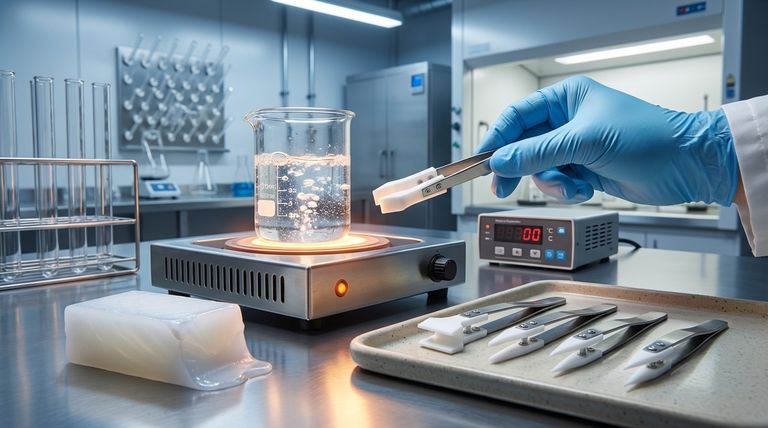In technical terms, Teflon is classified as a thermoplastic. This means that, unlike thermosetting plastics, it can be melted and reformed upon heating without undergoing a significant chemical change. More specifically, it belongs to a high-performance family of thermoplastics known as fluoropolymers.
The word "Teflon" is a brand name for a family of materials, not a single plastic. Understanding that it is a thermoplastic fluoropolymer is the key to grasping its unique behavior with heat and its world-renowned non-stick and chemical-resistant properties.

What "Thermoplastic" Means for Teflon
The distinction between a thermoplastic and a thermoset is fundamental to understanding a material's behavior, especially when exposed to heat. This classification dictates how Teflon is processed and what its limitations are.
The Fundamental Difference: Melting vs. Curing
Thermoplastics, like Teflon, have long polymer chains that are not chemically linked to each other. When heated, these chains can slide past one another, causing the material to soften and eventually melt into a liquid state that can be reshaped.
Thermosetting plastics, such as epoxy or Bakelite, form irreversible chemical bonds (cross-links) during a "curing" process. Once set, they cannot be re-melted; excessive heat will cause them to char and degrade rather than flow.
The Power of Fluoropolymers
Teflon's specific classification is a fluoropolymer. This is the source of its famous properties.
The bond between carbon and fluorine atoms in its molecular structure is exceptionally strong. This strong bond is what gives Teflon its remarkable chemical inertness and extremely low coefficient of friction (its "non-stick" quality).
"Teflon" is a Family, Not a Single Material
While the name is often used generically, "Teflon™" is a brand that encompasses several distinct types of fluoropolymers. Each is tailored for different performance characteristics and processing methods.
PTFE: The Original Non-Stick Polymer
Polytetrafluoroethylene, or PTFE, is the original and most famous material sold under the Teflon brand. It has the highest operating temperature and is one of the most chemically resistant substances known.
FEP, PFA, and ETFE: The Melt-Processable Cousins
While PTFE has incredible properties, its extremely high melting point makes it difficult to process with conventional techniques. Other members of the family were developed to address this:
- FEP (Fluorinated Ethylene Propylene) has a lower melting point, making it easier to injection mold.
- PFA (Perfluoroalkoxy) offers similar temperature and chemical resistance to PTFE but with better durability and clarity.
- ETFE (Ethylene Tetrafluoroethylene) is known for its exceptional toughness and strength.
Understanding the Trade-offs
Classifying Teflon as a thermoplastic reveals both its strengths and its inherent limitations. No material is perfect, and understanding these trade-offs is critical for proper application.
High Processing Demands
While being a thermoplastic means it can be melted, the melting point of PTFE is extremely high (around 327°C or 621°F). This requires specialized equipment and significant energy, making it more costly to manufacture parts compared to common plastics like polyethylene or polypropylene.
Susceptibility to Creep
Like many thermoplastics, Teflon can be subject to "creep." This is a tendency for a solid material to deform slowly and permanently under the influence of persistent mechanical stress, especially at elevated temperatures.
Not All "Teflons" Are Equal
The biggest potential pitfall is treating all Teflon-branded materials the same. Using a lower-temperature material like FEP in an application that requires the heat resistance of PTFE will inevitably lead to failure.
Making the Right Choice for Your Application
Your choice within the Teflon family depends entirely on the specific demands of your project. The thermoplastic nature of these materials allows for a range of options tailored to different needs.
- If your primary focus is maximum temperature and chemical resistance: Pure PTFE is the benchmark for performance, though it is more challenging to fabricate.
- If your primary focus is easier manufacturing via injection molding: FEP offers a trade-off, providing excellent fluoropolymer properties at a lower service temperature.
- If your primary focus is toughness and mechanical durability: ETFE or PFA are engineered for greater strength and resistance to abrasion compared to standard PTFE.
By understanding Teflon as a family of high-performance thermoplastics, you can select the precise polymer that meets your engineering and processing requirements.
Summary Table:
| Classification | Key Characteristics | Common Teflon Types |
|---|---|---|
| Thermoplastic | Can be melted and reshaped upon heating. | PTFE, FEP, PFA, ETFE |
| Fluoropolymer | Exceptional chemical resistance and low friction. | PTFE, FEP, PFA, ETFE |
| Thermoset (for comparison) | Irreversibly sets when cured; cannot be re-melted. | Epoxy, Bakelite |
Need High-Performance PTFE Components?
Understanding the classification of Teflon is the first step. The next is sourcing precision-manufactured components that leverage these unique properties.
KINTEK specializes in the custom fabrication of PTFE and other fluoropolymer components—including seals, liners, and labware—for the semiconductor, medical, laboratory, and industrial sectors. We help you select the right material (PTFE, FEP, PFA, or ETFE) for your specific temperature, chemical resistance, and durability requirements.
Let us bring your project to life, from prototype to high-volume production.
Contact our experts today for a consultation.
Visual Guide

Related Products
- Custom PTFE Parts Manufacturer for Teflon Parts and PTFE Tweezers
- Custom PTFE Parts Manufacturer for Teflon Containers and Components
- Custom PTFE Teflon Balls for Advanced Industrial Applications
- Custom PTFE Square Trays for Industrial and Laboratory Use
- Custom PTFE Sleeves and Hollow Rods for Advanced Applications
People Also Ask
- What finishing techniques are effective for machined Teflon parts? Achieve Functional Performance and Dimensional Stability
- What factors should be considered when choosing between Nylon and PTFE? Select the Right Material for Your Application
- What are the unique properties of PTFE? Unlock Unmatched Performance in Demanding Applications
- What fabrication services are available for PTFE? Shearing, Stamping, Laser Cutting, Molding & Machining
- What challenges arise when machining PTFE (Teflon)? Overcome Softness, Heat, and Instability



















